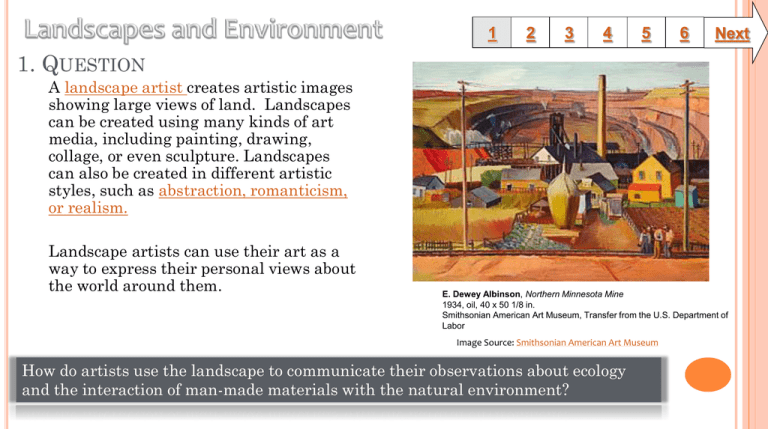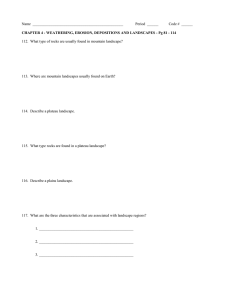
1
2
3
4
5
6
Next
1. QUESTION
A landscape artist creates artistic images
showing large views of land. Landscapes
can be created using many kinds of art
media, including painting, drawing,
collage, or even sculpture. Landscapes
can also be created in different artistic
styles, such as abstraction, romanticism,
or realism.
Landscape artists can use their art as a
way to express their personal views about
the world around them.
E. Dewey Albinson, Northern Minnesota Mine
1934, oil, 40 x 50 1/8 in.
Smithsonian American Art Museum, Transfer from the U.S. Department of
Labor
Image Source: Smithsonian American Art Museum
How do artists use the landscape to communicate their observations about ecology
and the interaction of man-made materials with the natural environment?
2. INFORMATION SOURCES
1
2
3
4
5
6
Next
Here are some examples of landscape artwork.
You will use these resources to analyze how
these artists use the landscape to express their
personal views about the world around them.
Ansel Adams
Claude Monet
The Hudson River School
Joel Sternfeld
Hockney, David, Garrowby Hill, 1998 oil on canvas, 60x76
in.
Vincent Van Gogh
Image Source: www.hockneypictures.com
Landscape Painting in Chinese Art
3. STUDENT ACTIVITY
1
2
3
4
5
6
Next
Explore the resources on slide 2 to
think about these questions:
How is the interaction of man-made
materials with the natural
environment depicted in the artwork?
What is the mood depicted in the
artwork? Does the artwork suggest a
positive or negative mood? How do
you know?
What message is the artist trying to
convey about the environment?
The Destruction of Lower Manhattan: Photographs by Danny Lyon
Danny Lyon, "327, 328, and 331 Washington Street, between Jay and Harrison Streets
Image Source: Museum of the City of New York
4. ASSESSMENT ACTIVITY
1
2
3
4
5
Choose one landscape artist from the
resources provided on slide 2. Make notes
in your art journal as you critique and
analyze:
Art medium used (oil, watercolor, photography,
collage…)
Style (abstract, realistic, surreal…)
What the environmental message is that the
artist conveys in his/her artwork
How the artist uses medium and style to
convey the overall message about the
environment
Use a Web2.0 tool to create a visual or
multimedia analysis of the artist and their
work. For example, you could create a
Glogster interactive poster, a VoiceThread,
an Animoto video, or another product
approved by your teacher. Web2.0 Rubrics
Bearden, Romare, Winter (Time of the Hawk), 1985
collage of various papers with paint, ink, and graphite on fiberboard
Private collection, Charlotte, North Carolina
Image Source: National Gallery of Art
6
Next
1
5. ENRICHMENT ACTIVITIES
2
3
4
5
6
Extend your learning about landscapes, art
styles, and art elements and principles:
Levee Farms
1998 Wayne Thiebaud Born: Mesa, Arizona 1920 oil on canvas 48 x 48 in.
(121.9 x 121.9 cm) Smithsonian American Art Museum
Image Source: Smithsonian American Art Gallery
Select the image to the left to view an infographic about Wayne Thiebaud
Courbet and the Modern Landscape
JMW Turner
Bernd and Hilla Becher, Photography
Romare Bearden Landscapes
National Gallery of Art for Kids: Rousseauian
Jungle Landscape
Birmingham Museum: Learning About
Landscapes
Scoop-It “Landscapes and Environment”
Art Styles and Movements
SFMOMA Art Basics: a slide show that explains
the elements of art
Next
6. TEACHER SUPPORT MATERIALS
BCPS/Maryland State Curriculum
Standard 1: Perceiving and Responding: Aesthetic Education: Students will demonstrate the ability to perceive,
interpret, and respond to ideas, experiences, and the environment through visual art.
Standard 2: Historical, Cultural, and Social Context: Students will demonstrate an understanding of visual art as
an essential aspect of history and human experience.
Standard 3: Creative Expression and Production: Students will demonstrate the ability to organize knowledge and
ideas for expression in the production of art.
Standard 4: Aesthetics and Criticism: Students will demonstrate the ability to identify, analyze, and apply criteria
for making visual aesthetic judgments.
Standard 5: Habits of Mind: Students will demonstrate positive attitudes and ethical behaviors that demonstrate
respect for the expression, ideas, abilities, and needs of others. Students will demonstrate and apply productive
artistic behaviors in order to make contributions to society
ISTE.Nets.t
1. Facilitate and Inspire Student Learning and Creativity
1
2
3
4
5
6
Time Frame: 20-30min
Differentiation:
Direct students to use comprehension tools
included in databases, such as: audio read-aloud,
labeled reading levels, and embedded dictionaries.
Learning Styles:
Visual, Reflective, Kinesthetic, Tactile
2. Design and Develop Digital Age Learning Experiences and Assessments
Common Core State Standards
Reading: 1. Read closely to determine what the text says explicitly and to make logical inferences from
it; cite specific textual evidence when writing or speaking to support conclusions drawn from the text.
Writing: 7. Conduct short as well as more sustained research projects based on focused questions,
demonstrating understanding of the subject under investigation.
Standards for the 21st Century Learner
1.1.6 Read, view, and listen for information presented in any format (e.g. textual, visual, media, digital)
in order to make inferences and gather meaning.
2.1.3 Use strategies to draw conclusions from information and apply knowledge to curricular areas,
real-world situations, and further investigations.
Maryland Technology Literacy Standards for Students
3.0: Use a variety of technologies for learning and collaboration.
Notes to the teacher:
Enduring Understanding: Artists draw inspiration
from and make artwork in response to their natural
surroundings.
BCPS Web2.0 Tools
Google Art Project
NGA Kids
text resources by reading level: silver/gold stars
(basic/challenging
Last updated: July 2015
Created by Anna Conner and Marilyn McDonald
BCPS Slam Dunk Research Model, Copyright 2012, Baltimore County Public Schools, MD, all rights reserved. The models may be used for educational, non-profit school use only.
All other uses, transmissions, and duplications are prohibited unless permission is granted expressly. This lesson is based on Jamie McKenzie’s Slam Dunk Lesson module.


